There’s no more terrifying feeling than seeing your betta floating at the top of the tank.
After the initial heart attack, though, you’ll need to take a good look at their environment.
When you have a betta fish staying at the top of the tank, they’re saying they need your help.
#1 Low Oxygen Levels

How Betta Fish Breathe
Betta fish are one of those unique fish species with a labyrinth organ.
One way they get oxygen is by swimming to the surface and breathing the air.
Even in a tank with pristine water conditions, they will regularly approach the tank’s surface.
However, betta fish rely a lot more on air oxygen when their water has an oxygen deficiency.
Instead of deriving most of their oxygen from water, they swim to the surface and breathe air.
Things are desperate when they start staying at the water’s surface instead of hanging out at the bottom of the tank.
The telltale sign of low oxygen in the tank is when you see your fish constantly poking at the surface and actively breathing.
When they aren’t poking out, they stay close to the surface. This is because they know they’ll need air again soon.
How to Raise Oxygen Levels
So, what’s the solution?
Add more oxygen to the tank by getting some small trinkets made for fish tanks.
Air stones are an easy installation for the fish tank and create bubbles of air in the tank.
These snap onto an air pump you probably already have in the aquarium. If not, here’s a helpful video on how to install one.

Bubblers are a popular installment of aquariums for various fish species.
Betta fish do great with these! They’re an efficient, fun way to increase dissolved oxygen levels in the water.
#2 High Ammonia or Nitrite Levels

How Ammonia Impacts Betta Fish
Ammonia and nitrite levels always need to stay at 0 ppm.
Nitrate levels, similarly, are best kept at < 40 ppm.
Better you ever add a betta to your aquarium, you already have tested for these chemicals and made sure they were okay.
Afterward, water changes are performed regularly (ideally every week).
Neglecting to do those partial water changes often results in ammonia build-up.
Of course, life happens, and neglect is rarely intentional. But this is serious and needs to be taken care of immediately.
Here are just a few of the issues your pets might face in poorly maintained water:
- Fin rot
- Losing bright colors
- Eye deformities
- Lethargy
Your betta fish can feel it when the water quality dives. They may approach the surface because they feel the need to escape.
With enough neglect, they will jump completely out of the uncovered tank.
Lowering Ammonia Levels
The best cure is prevention in this situation.
Keep up on your weekly partial water changes.
Use a good aquarium filter to maintain beneficial bacteria but keep the water clean.
However, if ammonia levels get out of control, here’s what to do:
- More partial water changes
- Sample for ammonia
- Identify the source of the problem
Increase water changes every couple of days until the problem resolves itself.
Usually, this doesn’t take a terribly long time and should be fixed within a week.
Test the water a couple of times after each change to see what those ammonia, nitrite, and nitrate levels are.
Continue sampling for ammonia semi-regularly after the crisis is over.
If ammonia levels don’t come back down, something is up.
Maybe the water is lacking in beneficial bacteria. A new filter will likely solve this problem.
Or if you’ve recently added snails to the tank, they may be producing extra ammonia.
#3 Crowded Tank

Why Crowding Is Bad for Betta Fish
A crowded tank is a recipe for disaster, especially when you have a siamese fighting fish.
You must be careful who you pair them with and supervise as much as possible until everyone is settled.
Sometimes, things go wrong even once all your fish get used to each other.
Sudden changes in water temperature will set someone off, and suddenly they bully your other, smaller fish.
Do not house your betta fish with a predator!
When a fish feels unsafe, they hide in whatever way it can.
Bullies result when a tank is too crowded. If your betta is the target of bullying, it may stay at the tank’s surface.
Even without bullying, an overcrowded tank is unsafe for all involved. Betta fish are often territorial and love their space.
They will become extremely stressed out with too many roommates. They may even get sick from stress.
Some species of small fish are okay with less room and more company.
But betta fish do poorly in these circumstances.
Fixing a Crowded Tank
The most straightforward answer is to get a bigger tank.
But this is not always feasible for everyone as larger tanks are considerably more expensive.
Another option is to separate your betta from their tank mates. Getting a second smaller tank is easier on the wallet.
However, it does mean you also need to get new supplies for the second tank. This includes a new filter, air pump, and plants and decor.
If your tank is already big enough, but your fish don’t get along well, use a tank divider instead of buying a new aquarium.
Community tanks are often hard to maintain, so don’t take it as a failure!
You’re doing the right thing by protecting your fish and making them feel safer.
#4 Small Tank
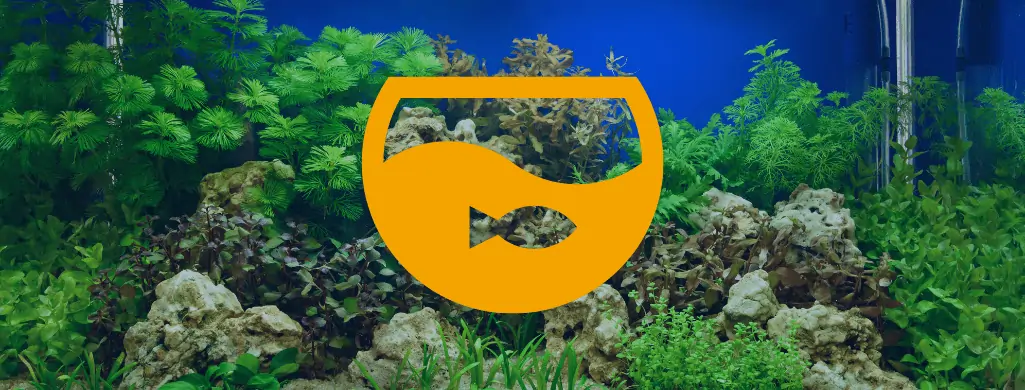
Even a lone betta fish needs lots of space to feel good in its home.
The idea betta fish can live in a 3-gallon tank is a common misconception. They need at least a 5-gallon tank to do well.
10 gallons is even better if you want to give them ample space.
If you keep more than one betta, they likely have a tank divider or two separate tanks.
When using a tank divider, make sure your tank is at least 10 gallons. Each betta fish needs at least 5 gallons of aquarium space.
Most people don’t put betta fish in community tanks since they tend to be angry little guys. But if you do give it a go, err on the side of caution.
The bigger your aquarium is, the better.
A betta who feels cramped and closed in will stay at the water’s surface out of desperation to get out of the tank and move around more.
The more company they have in their tank, the worse this feeling may become.
Upgrade your tank as soon as possible if you notice this behavior in your pet betta.
#5 Boredom
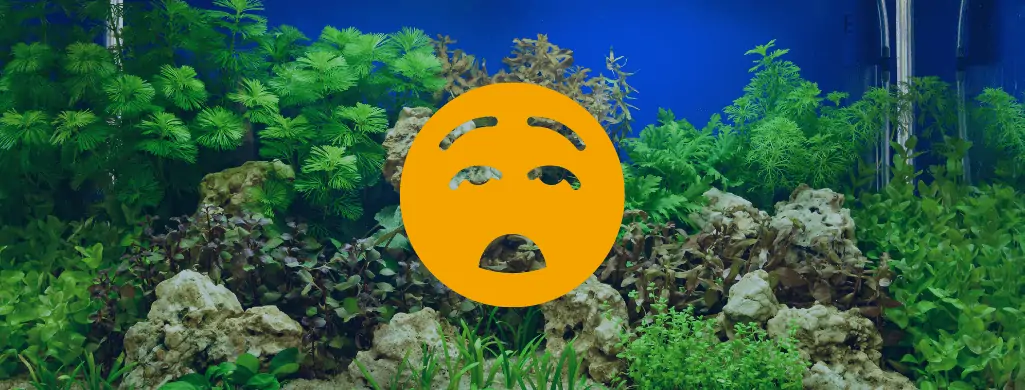
I know it sounds overdramatic, but an under-stimulated betta fish will act as if it will die from boredom.
My rabbit picks up the nearest toy and falls backward like a fainting Victorian woman when he’s bored. Pets are dramatic sometimes.
In all seriousness, betta fish need entertainment!
Plants and other decor are necessities when you set up your fish tank, just like a chemical filtration unit and thermometer are.
Live plants are great, but not everybody wants to use them.
If you go with artificial plants, get something made of soft silk or another gentle material.
Rough edges like those on fake-plastic water plants can cut or tear your betta’s fins.
More options for decor include driftwood and well-designed caves or statues.
Always check for jagged or rough edges before placing something in the tank.
But your betta will thank you for giving them obstacles to swim around and some pretty green plants to enjoy.
#6 Low Temperature
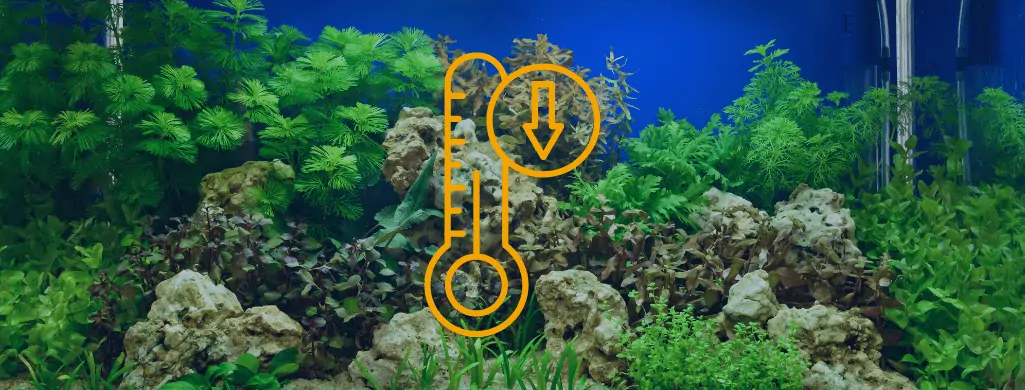
Seeking Warmth at the Surface
When temperatures in the tank start to get too low for your betta, they may spend more time in the upper sections of the tank.
This is because the water in the upper part of the tank is marginally warmer than the water at the bottom.
Catching the problem at this stage is actually really good.
Adjust your tank’s heater, replace it if you need to, and keep an eye on the temperature there. Things will be fine in a little while.
Your fish can suffer much worse effects from low temperatures, which are much more concerning.
Cold shock in betta fish looks like:
- Sinking to the bottom of the tank
- Acting lethargic
- Lack of appetite
- Entering coma
In the event things get this bad, immediate action is crucial.
Do a 25% or more water change to raise the temperature as quickly as possible.
This is a delicate process, though. Sudden temperature changes can make your betta fish sick.
Furthermore, you don’t want to overcorrect the problem and make the tank too hot. This comes with its own set of problems!
#7 High Temperature
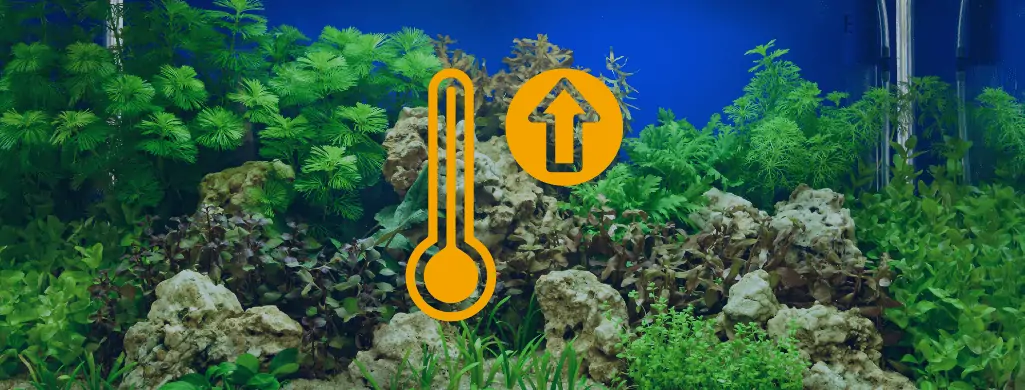
Heat Sickness in Betta Fish
Ironically, your betta may stay at the top of the tank if the temperature is too high.
Remember, the sweet spot for siamese fighting fish is a temperature of 78-80° degrees Fahrenheit (27° C).
Going slightly outside this range won’t seriously harm your fish. But the goal is always to keep to this optimal temperature.
When the tank starts to get too hot, this affects dissolved oxygen levels and stresses out your fish.
You’ll see them swimming up to the surface, gasping for air like a dog after a summer run.
This is a result of both physical heat and a lack of oxygenation.
They may also swim erratically around their enclosure, struggling to escape the heat.
They are tropical fish, but bettas still can’t survive in an excessively hot environment.
How to Cool Down Your Betta
It is key to do frequent partial water changes until the temperature is back where it needs to be.
Depending on your aquarium size, the water temperature will take more or less time to even back out.
Just like when you heat up the tank, you have to be careful not to over-correct as you cool down the tank.
This is why we only do partial water changes. Never change all the water in your betta’s tank at once.
It’s a good idea to check all the other water parameters in your aquarium while doing these water changes.
When one of the key water conditions is out of wack, others are too.
Sample for ammonia and test the pH. Make sure everything is looking okay for your betta.
Poor water quality is one of the leading causes of death in betta fish in captivity.
You’re not going to over-test the water parameters. Trust me!
#8 Too Much Waste

Effects of Waste Build-Up
Some fish produce more waste than others.
Maybe they go through a bout of illness or aren’t the best at finishing their food.
If you keep live plants in your aquarium, they help with some things. But dead plants are more waste in the tank.
The more fish and other aquatic life you keep in the tank, the more likely you are to deal with extra waste.
Whether a fish passes away in the tank or your pets poop a lot, crowded conditions are known to cause problems with waste.
Even with consistent weekly water changes, waste builds up sometimes.
Decreasing Waste
Combatting waste build-up is sometimes as simple as removing uneaten food within a few minutes after feeding.
Other times, it’s more complicated. If your fish consistently produce too much waste, you will have to change the water frequently.
Many people change 25% of the water in their fish tank twice a week because this is just what their pets need.
Another option is to get snails. Mystery snails are among the most popular types to add to a betta tank, as they share overlapping water parameters.
Many snails are good at cleaning up plants, food, and other kinds of waste in the aquarium.
The downside to adding shrimp to your setup is they sometimes produce a lot of ammonia.
This means you may still find yourself having to perform extra water changes.
#9 Swim Bladder Disease (SBD)
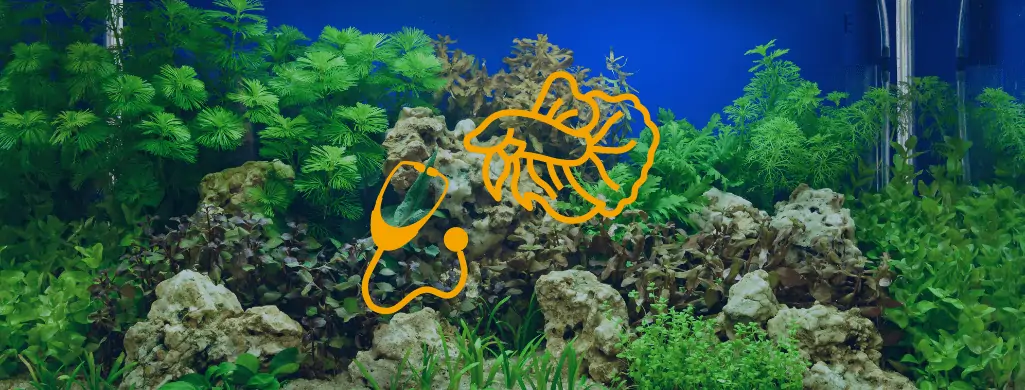
Swim bladder disease (SBD) is a common illness in betta fish which causes them to have trouble swimming in their usual pattern.
Instead of swimming straight, they often float toward the tank’s top.
If you notice your betta is struggling to swim normally, this is likely the problem.
SBD happens when we overfeed our betta fish or when they become constipated for some other reason.
There are other causes, such as stress, shock, and infections, but overfeeding is the most common.
To help your betta, you must stop feeding him for a few days. I know this sounds difficult, but it will help in the end.
After a few days, give your betta some food and watch closely to see if they produce any waste.
If they process the food and pass waste, the problem is mostly over.
The trick is to adjust how much you feed them to ensure they don’t get SBD again.
If your fish develops SBD for any other reason, it’s best to have them seen by a fish-savvy vet.
Sometimes this is easier said than done, so you may want to use the Epsom salt bath cure at home.
This trick involves combining conditioned tap water with some of your aquarium water and adding Epsom salt.
It doesn’t always work, but it is a great first step.
#10 “Feed Me!”
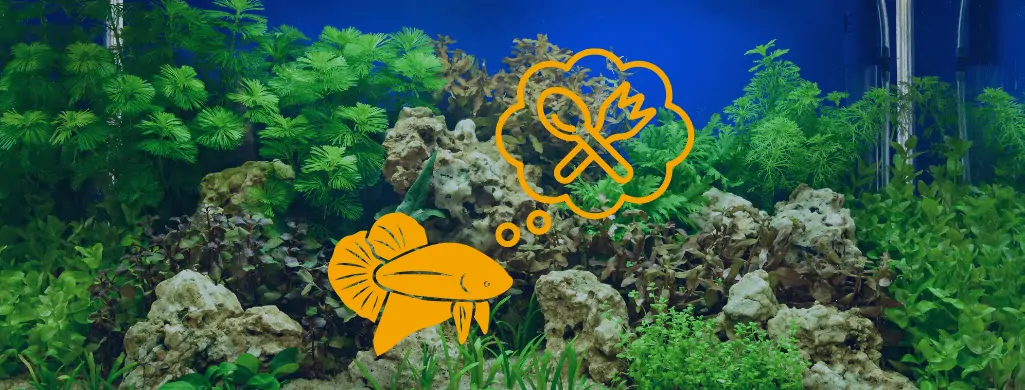
This is a slightly obvious answer as to why your fish would hang out at the top of the tank: They’re hungry.
While betta fish aren’t the most avid trick-learners of all pets, they make basic associations.
They know their food is dropped at the top of the tank, so they may hang out when hungry.
One way to test whether this is the problem is to put your finger at the top of the tank.
If your fish swims over to it, they expect you to feed them.
When they show no interest in your finger but continue to stay at the surface, there is another problem to deal with.
You most likely have a set feeding time for your fish, which is great.
But if you notice your betta is hungry, give them a small snack. Then consider adjusting how much they get at meal times.
Warning! Make sure you don’t put your finger in the tank itself.
There are several things to never put in your betta fish tank. Look at the link to see our picks of what to avoid.
Understanding Your Floating Betta
A lot of these problems sound scary. While they are urgent, they are mostly very easy to fix!
The fact you’re reading this means you’re working to keep your betta healthy and safe.
If you know someone else who’s faced this problem or is a new betta owner, send them our article. We want to help all betta owners understand their pets.


